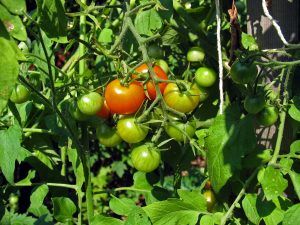Slicing into the first tomato of the season is a much anticipated moment for gardeners. Tomatoes are among the most popular fruit or vegetable plants grown in home gardens. Much of that popularity may be credited to the fact that red, ripe tomatoes have a delicious, juicy flavor that serves as the basis for all sorts of recipes. And since tomatoes can just as easily be grown in a full backyard garden or in a container on a patio or balcony, tomatoes appeal to gardeners regardless of their living situations.
 While tomatoes are relatively easy to grow, they are prone to certain problems and pests. Knowledge of what to expect when planting tomatoes and how to start off on the right footing can help produce a season’s worth of delicious bounty.
While tomatoes are relatively easy to grow, they are prone to certain problems and pests. Knowledge of what to expect when planting tomatoes and how to start off on the right footing can help produce a season’s worth of delicious bounty.
· Wait until after the last average frost date. Tomatoes can be grown from seeds outdoors in warm areas, but tomato gardeners often find success starting seeds indoors six to eight weeks before the last frost date. Gradually introduce seedlings to the elements for a few hours each day, increasing the duration of time outside. Then they can be transplanted outdoors when temperatures are consistently over 60 F.
· Choose a sunny spot. Tomatoes love to soak up sunlight, according to The Home Depot. Place the plants in a sunny spot so they can thrive.
· Space out plants. The experts at Better Homes and Gardens say to leave anywhere from 24 to 48 inches between plants to accommodate for growth and ensure the plants will not get stunted.
· Plant deeply. Tomatoes tend to root along their stems. If transplants are long and lean, dig a trench and lay the stem sideways in the dirt, and then bend the top of the plant upward. Snip off the lower branches and cover with soil up to the first set of leaves. This will produce extra root growth and stronger, more vital plants.
· Give the plants support. Tomato cages or stakes can help keep the leaves and fruit from touching the ground, which can cause rot and, eventually, death to the tomato plant.
 · Lay down a layer of mulch. Tomatoes grow best when the soil is consistently moist. Mulch can help retain moisture from watering and rain. Mulch also will help prevent soil and soilborne diseases from splashing on the leaves and plants when it rains. While you amend the soil, make sure that it drains well and is slightly acidic.
· Lay down a layer of mulch. Tomatoes grow best when the soil is consistently moist. Mulch can help retain moisture from watering and rain. Mulch also will help prevent soil and soilborne diseases from splashing on the leaves and plants when it rains. While you amend the soil, make sure that it drains well and is slightly acidic.
· Prune away suckers. Tomatoes produce “suckers,” which are leaves that shoot out from the main stem. Removing these leaves promotes air circulation and keeps the plant’s energy focused on growing fruit.
Tomatoes are a rich addition to any garden. A few simple tricks can help even novice gardeners grow delicious tomatoes.



